Vehicle documentation can be a time-consuming task for investigators, whether the documentation takes place at a crash scene, on a city side street, at an impound lot, in a scrap yard, or any other place a vehicle may be found.
OSCR360 excels at documenting and processing a vehicle, because it allows investigators to efficiently capture every inch of a car, both inside and out, including the rooftop and the undercarriage. After capturing the scene overalls, investigators can snap individual evidence photographs with their DSLR cameras, and then connect the evidence to the scene as Points of Interest in the OSCR360 software. Crime scene technicians, crash reconstructionists, forensic consultants, and other scene examiners have all found value in OSCR’s ability to capture, store, organize, and visually present the facts of a case.

How to document a vehicle using OSCR360:
Forensic Consultant and Crime Scene Photographer Andrew McNeill recommends beginning the documentation process simply by capturing all four corners and all four sides of the vehicle using a standard tripod. Not only will the vehicle exterior then be sufficiently documented, including the license plate, but the vehicle’s surroundings will be captured as well. So, whether a vehicle is upside down in a ditch or has been discovered in a vacant lot, OSCR360 will capture the full context of the scene.
Next, place OSCR360 on top of the vehicle, still using a standard tripod. A compact car may only require 1-2 photos from the rooftop and hood, whereas a large truck may need 3-4 photos to include the truck bed. On the same tripod, hold OSCR360 in position below the vehicle. Again, be sure to capture the entire underside taking as many OSCR360 images as needed.
For the vehicle interior, determine whether you will be holding OSCR through a door or window on the standard tripod, or if it would be better to put the camera on a mini-tripod to stand on the seats. This decision will vary based on the specific conditions at a scene. To sufficiently capture the interior, capture a photo from each seat, as well as the center console and below each seat. Determine the best course of action for the trunk or a truck bed that is covered with a tonneau cover, as well.
OSCR360 can also capture all of your tire data in one easy-to-capture 360 image. Place OSCR on a mini tripod, roughly a foot from the center of each tire. As long as you position OSCR360 at the same height and distance for each tire, you will be able to document the words on the tires, the tread pattern, and any tire impressions left in the surrounding environment.
Pro tips for best results
In addition to the photographs themselves, keep in mind that OSCR’s sensor tube “stamps” each photo with GPS data. This can be particularly helpful after discovering an offsite vehicle that has been involved in a hit and run or is part of a search warrant.
Here are McNeill’s additional tips for documenting and processing a vehicle with OSCR360:
- Position the lens directly toward the vehicle while photographing the four sides and corners.
- Use the HDR setting for extra clarity in photographs. This is particularly important for darker conditions under a seat or beneath the vehicle.
- Center OSCR360 between the wheels on the roof, hood, and/or truck bed/tonneau cover for best results.
- Position the camera lens as close to the center of the tire hub as possible so that every point around the outer circumference of the tire is equidistant from the lens, minimizing any distortion of the sidewall writing.
- Ensure that for each tire image, OSCR360 is placed the same distance away from the tire as in the other images to keep all photos consistent.
- Use chalk or a lumber crayon to help the words on the tires stand out before photographing.
- Always use great care when placing the OSCR360 camera into position (i.e. under the vehicle) to avoid scratching the lens.
- Check your photographs on the tablet for quality purposes as you take them in case there are any photographs that you wish to re-take.
Watch L-Tron team members, John & Andy, document a vehicle:
Various Vehicle Documentation Scenarios:
OSCR360 is a highly valuable tool used to assist investigators with documenting and processing a vehicle that was involved in search warrants, crashes, crime scenes, fires, and more. Regardless of the purpose for documenting the vehicle, the same basic steps apply. However, there are some idiosyncrasies to be aware of, depending on the circumstances surrounding an investigation.
Vehicle Search Warrants
An effective approach for documenting a search warrant involves quad-ranting out the car by putting the camera on the driver’s seat for a photo, then the passenger seat, then on the rear driver’s side seat, and then on the rear passenger seat.
In cases where the vehicle is a mess from trash, blood, or vehicular damage, OSCR can be placed on a tripod and inserted into the vehicle through a window. Photos taken sideways or upside down are self-righting, so the angle that you position the OSCR360 camera at does not affect the photo. It is also recommended to photograph under the seats using OSCR360 upside down on a pole prior to conducting a hand search to check for dangerous items, such as a razor blade, broken glass, or needles.
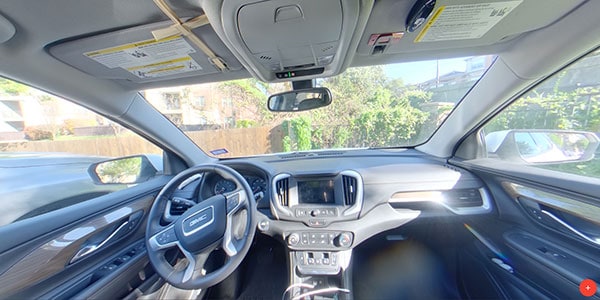
Once the vehicle search warrant is complete, each piece of digital evidence collected can be incorporated into the OSCR360 desktop software. In the OSCR360 software, viewers can see exactly where each piece of evidence was discovered and how it was connected to the scene or a larger crime.
Motor Vehicle Collisions
Any type of major crash scene requires systematic photo documentation. OSCR360 will not only provide that documentation but will also provide context for where exactly each vehicle was located at the scene.
OSCR360 can show perspective as to how the crash occurred, striations and skid marks in the road and overall vehicle damage. Within the OSCR360 software, other digital evidence, such as dash cam footage, red light camera footage or DSLR photos taken at the scene can all be incorporated into your OSCR360 project. Capture any crush damage from the rooftop of the vehicle for an aerial perspective. To capture the broader aerial perspective of the scene, again place OSCR360 on the rooftop of the vehicle, by using its 27-foot tripod.
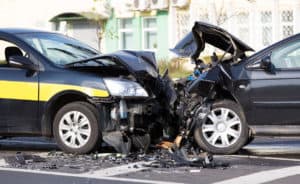
OSCR360 thoroughly captures vehicles in their entirety using far fewer photographs than traditional DSLR photography requires. For instance, capture all of the tire data in just one shot instead of numerous photos. Unlike traditional photography, spherical photography is also highly effective at capturing the driver’s perspective from within the vehicle. Within the OSCR360 software, you can use the images showing driver’s perspective to walk a judge or attorney. See through the driver’s eyes the vehicle’s interior (i.e. “A” pillar, “B” pillar, mirrors, etc), as well as the environmental surroundings outside of the car. Even when there has been significant crush damage, OSCR360’s small footprint allows it to be placed inside cramped spaces for photos that traditional photography simply does not allow.
Vehicles Connected to a Crime
When it comes to investigating a hit-and-run, OSCR360 does an exceptional job documenting the damage to a vehicle caused from the impact of a human body. Capture a damaged windshield, a missing mirror, broken lenses, front end damage, side door damage, and more. See any impressions or blood spatter that was left on the hood, windshield, or top of the car.
In a scenario where someone was run over, place OSCR360 underneath the car frame to capture photographs of the forensic evidence, such as hair, fibers, and clothing samples.
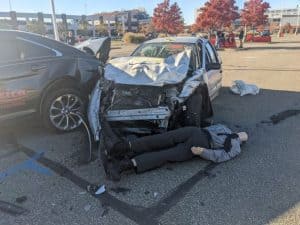
Vehicle fires
Following a vehicle fire, damage can render a vehicle almost unrecognizable and leave the conditions almost impossible to comprehensively photograph. Using OSCR360’s HDR setting, the camera can be placed in the vehicle on a tripod and capture clear images of the burn patterns and interior damage, despite poor lighting and other environmental challenges.
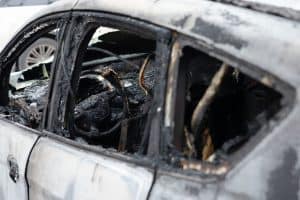
OSCR360 makes challenging vehicular crime scenes easier to document and process
No matter the exact circumstances, motor vehicle crashes and crime scenes lend themselves to a wide variety of tricky situations. Capture your scene overalls with OSCR360, including difficult to photograph scenarios such as:
- Cramped interior spaces (under the seats, in the trunk, or following crush damage)
- Cramped exterior spaces (an impound parking lot)
- Dark lighting conditions (below the vehicle or photos at night)
- Hazardous conditions (the presence of sharp objects or bodily fluids)
- Aerial photography (impressions on the hood, windshield, and rooftop)
- Time sensitive environments (a road closure needs to be reopened ASAP)
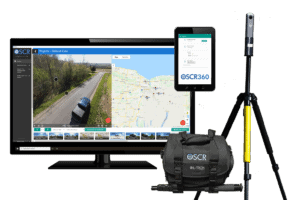
How else are agencies using OSCR360?
In addition to documenting and processing a vehicle crime, public safety agencies are using OSCR360 to capture, store, organize, and present all sorts of crime, fire, and environmental scenes, as well as for search warrant execution, and emergency/active threat preplanning in schools and other public buildings.
OSCR360 is an effective training tool for law enforcement and fire agencies, as well as university-level training courses. District attorney offices are taking OSCR360 into the courtroom to effectively present the facts of the case to juries in a virtual walkthrough format. The possibilities are endless when it comes to using OSCR360, and agencies nationwide are sharing new ideas with us on a regular basis.